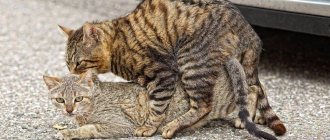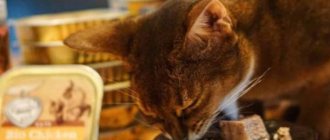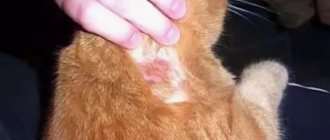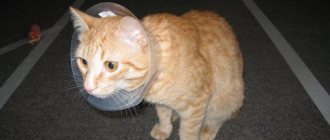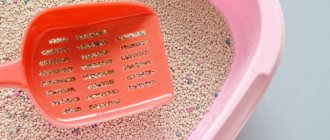Various wounds and other damage to the skin are the most common reason for a cat owner to contact a veterinarian. Naturally curious and active animals, they constantly expose themselves to the risks of injury.
Wounds in domestic cats are not a rare occurrence and all owners of mustachioed pets have encountered it. The cause of a wound in a cat can be damage in everyday life, fights with relatives or yard dogs.
Much will depend on the origin of the wound, its size and depth, as well as the possibility of introducing pathogenic microflora into it. In particular, a veterinary specialist, based on the results of the clinical picture and laboratory tests, prescribes an adequate therapeutic course, which, in turn, will prevent serious complications associated with a cat’s wound that is not treated in a timely manner.
Processing rules
As a rule, a cat gets an abrasion on the street while defending its territory or during the period of sexual heat. The injuries received can be of a different nature.
Weeping wound
Wet ones are treated dry, provided that the pet does not remove the bandages. If there is purulent exudate, you can apply a gauze pad soaked in a hypertonic solution of table salt or Vishnevsky ointment to the wound. But such treatment will be successful only if tissue regeneration is going well.
If there is no improvement, then surgery should be resorted to to resect the necrosis.
Weeping wound on a cat
Deep
If the wound scratch is deep enough, then treat it with a solution of Chlorhexidine or Miramistin, carefully inserting the nozzle of the bottle into it. Inject Levomekol ointment into the cavity using a syringe without a needle. Procedures must be performed 2-3 times a day until complete healing. You should put on a special collar for your pet so that he doesn’t injure you further by licking her.
In any case, try to get an appointment with a veterinarian as soon as possible to adjust the treatment.
Wound on paw
Open
The first step is to treat the surface with hydrogen peroxide. If the sore is large and without purulent discharge, then you can treat it with Novocaine solution for pain relief, just by pouring a little on it. Then you can sprinkle streptocide powder on it, it disinfects and promotes speedy healing.
Large open
Bleeding
The first step is to stop the bleeding. To do this, clamp the surface with your hands or bandage it tightly. You can also apply a tourniquet above the injury and attach a note indicating the time of application. The tourniquet should not remain on the cut for more than 2 hours. For shallow wounds, treat with hydrogen peroxide.
Do not use disinfectants as they can cause severe irritation and slow down healing.
After emergency measures are taken, the animal should be taken to the clinic for treatment.
Bandaged Paw
With purulent discharge
Hydrogen peroxide or chlorhexidine are suitable for disinfection. To prevent the spread of infection, you can give an injection of an antibiotic, for example, Sinusol 50 mg. The full course of treatment is 7 days.
If there is pain, heat, swelling and hyperemia in the area of injury, you should contact a veterinary clinic. This may indicate the development of an abscess, which requires professional treatment.
Superficial
Initially, you should wash the wound with hydrogen peroxide. Then treat with Baneocin or Neosporin. It is recommended to apply ointments up to 3 times a day. If possible, try not to cover the wound sore with a bandage. With air access it will heal faster.
On the surface of the skin
Burn
Treatment of burns depends directly on their severity. Initially, you need to apply a cold compress to the damaged skin for 20 minutes. Then treat it with a weak solution of potassium permanganate or anti-burn ointment. Then apply a sterile gauze bandage.
After this, it is necessary to show the animal to a doctor to prescribe effective treatment.
Bald spot on head due to burn
If meat is visible
Initially, you should treat it with 3% hydrogen peroxide. Afterwards, you can apply brilliant green around the wound surface, and sprinkle the wound itself with Baneocin or treat it with Sanotol spray. After this, apply a sterile gauze pad and immediately contact a veterinarian.
Torn to the meat
Features of care and feeding patterns for cats with wounds
A cat that has been diagnosed with a wound should be kept at rest until all injuries are completely healed. It is not recommended to let such a pet outside, and it is also necessary to protect it as much as possible from contact with other animals. Feeding plays an important role in the rehabilitation process of a cat with a wound. It must be balanced and aimed at fighting infection:
- Foods with irritating effects should be removed from the cat’s diet: smoked meats, sausages, sweets;
- it is necessary to increase the amount of vegetables, which contain vitamins and microelements necessary to stimulate the immune system;
- Additionally, you can give a sick cat synthetic vitamin complexes prescribed by a veterinarian.
How to speed up wound healing
To speed up healing, you should strictly follow the veterinarian’s recommendations. You can also use special long-acting wound-healing wipes for cats, for example, Antivtex. The use of antibiotics prescribed by a doctor will also promote rapid regeneration of damage.
In addition, it is necessary to provide the animal with complete rest and prevent licking. To do this, you need to use special collars and tightly secured gauze bandages that the pet cannot remove on its own.
Suture after surgery on a cat
What to look for
Fresh wounds usually appear partially or completely:
- Bleeding
- Swelling
- Lack of hair
- Cut, scratched or torn skin
- Lame
- Tenderness or pain
If a fresh wound is not visible, it may become infected.
In addition to swelling and soreness, you may experience the following:
- Discharge (pus) from the wound
- Abscesses (that is, a collection of pus under the skin) and the resulting hole in the skin when the abscess is opened and drained.
- Signs of a fever (such as lethargy and ears that feel hot to the touch)
Treatment with antibiotics
Antibacterial drugs are used to prevent secondary infection. As a rule, the remedy is selected by the veterinarian depending on the abrasion. The doctor will also prescribe the exact dosage. The most commonly prescribed drugs are tetracyclines, Ampicillin, Streptomycin. For infection, Amoxicillin, Clindamycin or Benzylpenicillin are recommended.
To summarize, we can say that only a veterinarian can determine how to treat a cat’s wound for effective treatment. After all, the healing process directly depends on correctly selected drugs. In any case, after providing emergency care to your pet, it must be shown to a specialist. Only a veterinarian can prescribe medications that will speed up the healing process and prevent secondary infections from occurring.
First aid
After discovering a wound on your pet, give him first aid. Examine the cat and assess its condition; if it does not cause concern, then you can provide first aid yourself.
First aid:
- remove hair near the wound;
- wash the wound with antiseptic drugs - furatsilin solution, hydrogen peroxide, chlorhexidine;
- try to stop the bleeding;
- the skin around the wound can be treated with brilliant green.
After providing first aid, take the animal to a veterinarian. The doctor will select the optimal treatment regimen and show you how to properly carry out the treatments.
Possible complications
Through the scratches of a domestic cat, a person can become infected with many rather unpleasant infections. One of them is felinosis or cat scratch disease. This type of pathological process is characterized by acute bacterial damage to the body.
A cat's claws, located at a special angle, easily penetrate the skin, injuring several layers of the dermis at once. Pathogenic microorganisms located on the paws and claws of an animal penetrate the human body. Animal saliva contaminated with foreign bacteria can also provoke the development of felinosis in humans.
The infection caused by Bartonella adapts perfectly in the animal’s body, circulating in urine, bloodstream and saliva. Naturally, bartonellosis is also found on cat paws.
In the first stages of felinosis development, a person experiences an inflammatory process in the tissues of the lymph nodes. In cats, bartonellosis is transmitted through the bites of blood-sucking parasites. After damage to the tissues of the lymph nodes, edema develops, body temperature increases, signs of poisoning and even an allergic reaction arise.
Felinosis poses the greatest danger to young children and adults with weakened body defenses (especially after suffering from a dangerous disease). It is important to note that BCC is not transmitted from person to person.
There are several forms of felinosis - typical and atypical. The first type of disease is characterized by moderate development. At the site of the injury (healed), a small blister begins to form, which bursts and forms a small ulcer covered with a crust. A person’s well-being does not change much.
Drugs
Today, in the pharmacy chain you can purchase a large number of medications that disinfect the wound. Accordingly, the choice of medication directly depends on the wound surface, its size, depth and the possibility of further infection. Treatment measures, prevention of secondary infection and eradication of surface healing depend on these factors.
Hydrogen peroxide
Treatment with this drug is possible no later than 2 hours from the moment of injury. Do not pour the bottle directly onto the wound. It is better to moisten the swab with the solution and treat the surface. If possible, apply a sterile dressing. But remember that during treatment you must hold your pet tightly.
Levomekol ointment
Used to accelerate wound healing and to prevent infection. The main active component accelerates metabolic processes in tissues and promotes the removal of purulent contents. To treat and prevent further infection, apply a bandage to the surface of the wound.
Baneocin ointment
It is excellent for treating infected wounds. The drug is not addictive and can be used up to 2-3 times a day. After treatment, it is recommended to cover the wound with a sterile cloth.
Iodine solution
Important! Do not apply the product directly to the wound surface. Dissolved iodine can be used to treat the edges of the wound without touching the wound itself. But, if there is a weeping wound, iodine will dry the surface, thereby protecting the animal from further infection.
Brilliant solution
Treating the wound with brilliant green should be done very carefully to avoid burns. It is not recommended to treat a weeping or bleeding wound with brilliant green. At its core, brilliant green solution is a powerful external antiseptic. Penetrating into the wound surface, it destroys pathogenic microorganisms and prevents the proliferation of bacteria.
Therefore, it is better to apply an aseptic dressing treated in a solution of brilliant green to the wound surface.
Furacilin solution
Furacilin still occupies a leading position for wound treatment. As a rule, to prepare a solution, 20 mg tablets are prescribed, which must be dissolved in 100 ml of water. The prepared solution should be stored in the refrigerator. The wound surface is treated with the product 2-3 times a day.
Rinse should be done away from the wound if it is fresh, and towards the wound if it has an inflammatory process.
Do I need to treat or will it heal on its own?
The opinion that everything heals quickly on cats because they lick their wounds is wrong. Even small injuries can develop into serious wounds if not treated promptly. Damage often occurs due to the action of dirty objects, which can cause infection.
What to give your cat for diarrhea at home
If a cat has a fight with another pet and there are wounds from the teeth, they quickly become crusty. Upon examination, it appears that the surface is healing and the damage is not dangerous. However, when bitten, the teeth penetrate into the deep layers of the skin, which is dangerous for infection. The top layer may heal within a few days, but the microbes that get inside begin to multiply.
Important! The infection quickly spreads throughout the body, and the wounds fill with pus. If left untreated, necrosis and blood poisoning may develop.
Why are scratches from a cat dangerous?
Scratches from cats and bites from these domestic pranksters are much more infected than bites from domestic dogs. In the overwhelming majority, infectious agents located on the paws and claws of cats are not isolated. Polymicrobial flora contains streptococcal infection, staphylococcal bacilli, pasteurella and some others. It is worth noting that bacterial pathogenic microorganisms are present on the paws and claws of all cats, without exception, even the most domestic and well-groomed ones.
In addition to the bacteria described above, after a scratch a person may develop the so-called felinosis, or cat scratch fever. The marks left by a cat on the owner's body are not harmless. Cat scratch disease can cause quite serious allergic reactions in humans and provoke dangerous complications in the organs of the human body.
The spread of pathogenic bacterial pyogenic microflora is due to the fact that the claws of domestic and wild cats have a curved shape. With the help of its weapon, the cat breaks the surface layer of the dermis. As a result of the penetration of pathogenic microflora that provokes BCC, first of all, the size of the lymph nodes changes. Wounds caused by a cat take a long time to heal, as they are not even.
Cat scratches have jagged edges, which delays the regeneration and recovery process. Deep torn scratches transform into a closed type of damage. It accumulates dirt and pathogens. Before treating a wound surface formed by a cat’s claws, it is necessary to thoroughly treat it to remove all kinds of dirt and infection, which will allow the body to easily regenerate the damaged area with new tissue.
How to care for a cat during the recovery period?
Watch the cat. If the wound was small and the animal immediately received adequate help, there should be no lethargy, drowsiness, vomiting, diarrhea or other “strange” signs. In the event that you observe something similar to your slightly injured pet, immediately call a veterinarian. These clinical signs clearly indicate a sharp deterioration of the pathological process.
Important! Discourage your cat from constantly trying to scratch the wound, tighten the post-operative bandage, or remove the drainage from the wound channel. Let us note, by the way, that for any wound, cats need a surgical (aka Elizabethan) collar, since otherwise they will definitely lick the damaged tissue.
If your pet is completely restless, it is recommended to use “aggressive” models that give a slight electric shock when trying to get rid of the collar. T-shirts and rompers for babies can be used as a “budget option”: if the animal is pulled into them, it will no longer be able to reach the wound (well, at least it will get very tired). Of course, the “clothes” need to be changed more often.
If you see that the edge of the drainage has appeared from the canal , be sure to inform the treating veterinarian about this. It is believed that the ideal time to replace drainage is every 12 hours. But in reality, it is rare that an owner can take a pet to the veterinarian with such frequency. There are two ways out: either do the replacement yourself, or extend the period to 17-20 hours. In principle, there is nothing wrong with this. If the wound looks clean, dry and closed, you can leave the drainage system without any fear: nothing bad will happen. Just make sure your cat can't lick the wound.


